Symptoms of Polycystic Ovarian Disease

|
Polycystic ovary is the main cause of female infertility. Therefore, for female friends, it is better to treat polycystic ovary more actively, which can also increase the possibility of female pregnancy. Moreover, this is a disease of the endocrine system, so the endocrine system needs to be adjusted accordingly, which is to increase the estrogen in the female body. So what are the symptoms of polycystic ovary? Polycystic ovary syndrome is one of the main factors leading to female infertility. It is a syndrome caused by excessive production of androgens by the ovaries. The excessive production of androgens is due to the synergistic dysfunction of multiple endocrine systems in the body. Patients with this disease have oligomenorrhea or amenorrhea, infertility, and cystic enlargement of both ovaries. What are the symptoms of polycystic ovary syndrome? (1) Hirsutism: Excessive androgens in the body cause hirsutism, so the distribution of hair tends to be masculine, such as increased beard, chest hair, hair from the navel to the pubic area, and hair on the anus and limbs, and thick, dense and black pubic hair. (2) Obesity: About 25% of patients will suffer from obesity. The relationship between obesity and PCOS is very complicated. The symptoms of PCOS may be related to decreased insulin sensitivity, and obesity still exists even after androgen levels return to normal. (3) Chronic anovulation: manifested as menstrual disorders, infrequent menstruation, scanty menstrual flow, or even amenorrhea. Symptoms of polycystic ovary syndrome are that a few patients have menstruation very rarely, with heavy menstrual flow and long menstrual periods. (4) Infertility: Infertility may be caused by anovulation due to hormonal disorders or ovarian insufficiency, or it may be caused by poor egg quality or progesterone deficiency, which causes poor growth of the endometrium and is not conducive to the implantation and development of the fertilized egg. What tests are needed for polycystic ovary syndrome? 1. Diagnosis based on symptoms: Women with PCOS have very regular menstruation, with a cycle of 3 to 6 months or a year. A few people have excessive menstrual flow or irregular bleeding. Patients with polycystic ovary syndrome often develop small pimples, mainly distributed on the face, around the breasts, and lower abdomen. 2. Ultrasound examination: It can be seen that the ovaries on both sides are symmetrically enlarged, and there are multiple small cysts of varying sizes in the ovaries. The diameter is 2~6mm and is mainly distributed around the ovarian cortex. 3. Hormone measurement: LH and FSH are abnormal, FSH (follicle-stimulating hormone) is at a low level, LH (luteinizing hormone) is high, forming LH/FSH ≥ 2~3, and androgen (T) levels are increased. 4. Endometrial biopsy: Endometrial biopsy performed before or during menstruation may reveal anovulatory proliferative endometrium or endometrial hyperplasia. 5. Laparoscopic examination: It can be directly seen that the bilateral ovaries are multicystic and enlarged, and the capsule is thickened and grayish white. |
<<: How long does it take to cure polycystic ovary?
>>: The harm of having a second child with triple positive
Recommend
How to take care of a female dog after sterilization? Should the uterus or ovaries be removed?
Nowadays, many families have dogs. When the puppi...
This article on procrastination was originally scheduled to be published in January
You have a work due tomorrow morning, so you crea...
What should I pay attention to when I have leg cramps during my fifth month of pregnancy?
Since pregnancy is a special period for women, th...
Signs that a woman is cheating when she is sleeping, detailed explanation of the specific manifestations of a woman cheating!
Most women are more sensitive and emotional than ...
Can pregnant women eat tripe?
Whether you use tripe to make hot pot or spicy ho...
How to self-test pregnancy if menstruation is delayed?
There are two main reasons for delayed menstruati...
Treatment for menstrual abdominal pain
Because many friends are accustomed to eating som...
Can I have a painless abortion in two months?
There are many situations in daily life. Some peo...
Wang Shuxian at PUMC: Clinical research on early diabetes in China
Wang Shuxian is a senior diabetologist and nephro...
Kendo UI: 2014 Mobile Survey Report: HTML5 vs Native Debate
Kendo UI’s investigation yielded several key conc...
How many months is 10 weeks pregnant
The normal calculation of gestational age starts ...
Pregnancy 1 to 9 months fetal position changes
The posture and position of the fetus in the uter...
I haven't had my period for two months.
If the possibility of pregnancy is ruled out, the...









